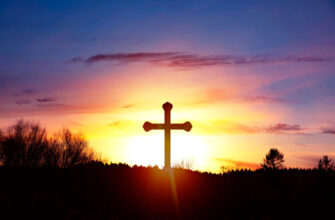Christianity is one of the most widely practiced religions in the world, with over 2 billion followers.
However, it is not a monolithic faith, and there are numerous denominations and traditions within Christianity. These different types of Christianity can vary widely in their beliefs, practices, and organizational structures.
Understanding the differences between these various branches of Christianity can be challenging, but it is essential for anyone seeking to learn about this religion.
From Catholicism to Protestantism to Orthodoxy, each type of Christianity has its unique history, beliefs, and practices.
In this article, we will provide a comprehensive guide to the different types of Christianity, including a full list of the major denominations and an overview of their key differences.
History of Christianity
Christianity is a monotheistic religion that originated from the life, teachings, and death of Jesus Christ in the 1st century CE. It is one of the world’s largest religions, with over 2.3 billion followers worldwide.
The history of Christianity is divided into several periods, including the Early Christian period, the Middle Ages, the Reformation, and the Modern period.
During the Early Christian period, Christianity spread rapidly throughout the Roman Empire and beyond, despite persecution from the Roman authorities. The Middle Ages saw the development of the Roman Catholic Church, which became the dominant religious institution in Europe.
The Reformation was a 16th-century movement that led to the establishment of Protestantism as a separate branch of Christianity.
This period was marked by religious wars and conflicts, as well as the emergence of new Christian denominations such as Lutheranism, Calvinism, and Anglicanism.
The Modern period has seen the continued growth and diversification of Christianity, with the emergence of new denominations and movements such as Pentecostalism, Evangelicalism, and the Charismatic movement.
Today, Christianity is practiced in every part of the world and is characterized by a wide range of beliefs, practices, and traditions.
Major Branches of Christianity
Christianity is the world’s largest religion, with over 2.4 billion followers worldwide. It is divided into several major branches, each with its unique beliefs and practices. The three main branches of Christianity are Catholicism, Protestantism, and Orthodoxy.
Catholicism is the largest branch of Christianity, with over 1.2 billion followers worldwide. It is led by the Pope, who is considered the spiritual leader of all Catholics. The Catholic Church believes in the Holy Trinity, the divinity of Jesus Christ, and the importance of the sacraments.
The Church also places a strong emphasis on tradition and the authority of the Pope. Protestantism is a diverse group of Christian denominations that emerged during the Reformation in the 16th century.
Protestants reject the authority of the Pope and many of the traditions of the Catholic Church. They believe in the importance of faith in Jesus Christ, the Bible as the ultimate authority, and the priesthood of all believers. Some of the largest Protestant denominations include Baptists, Methodists, Lutherans, and Anglicans.
Orthodoxy is the third major branch of Christianity, with over 250 million followers worldwide. It is based on the teachings of the early Christian Church and places a strong emphasis on the sacraments, icons, and the liturgy.
The Orthodox Church is led by a group of bishops, and there is no single leader like the Pope in Catholicism.
In addition to these three major branches, there are also several smaller branches of Christianity, such as the Anglican Communion, the Adventist Church, and the Jehovah’s Witnesses.
Each of these branches has its unique beliefs and practices, but they all share a common faith in Jesus Christ as the Son of God and the Savior of humanity.
Catholicism
Catholicism is a branch of Christianity that is led by the Pope and is based in Rome. The Roman Catholic Church is the largest Christian denomination in the world, with over 1.3 billion members.
Catholicism is distinguished from other branches of Christianity by its belief in the authority of the Pope, the use of sacraments, and the veneration of saints and Mary, the mother of Jesus.
The Catholic Church traces its origins back to the Apostles, particularly Saint Peter, whom Catholics believe was the first Pope.
The Church has a hierarchical structure, with the Pope at the top, followed by cardinals, bishops, and priests.
Catholics believe in the Holy Trinity, that is, that there is one God in three persons: the Father, the Son (Jesus Christ), and the Holy Spirit.
Catholicism places a strong emphasis on the sacraments, which are considered to be outward signs of inward grace.
The seven sacraments are Baptism, Confirmation, the Eucharist, Penance, Anointing of the Sick, Holy Orders, and Matrimony. Catholics believe that the Eucharist is the true body and blood of Jesus Christ and that it is necessary for salvation.
Orthodoxy
Orthodoxy, also known as Eastern Christianity, is one of the three major branches of Christianity, alongside Roman Catholicism and Protestantism.
It originated in the Eastern Roman Empire, which is now modern-day Turkey, and has spread throughout the Balkans, the Middle East, and former Soviet countries.
One of the key differences between Orthodoxy and other branches of Christianity is the importance placed on tradition and liturgy.
Orthodox worship services are highly ritualistic, with a heavy emphasis on icons, incense, and chant. The liturgy is conducted in the local language and often lasts for several hours.
Another distinguishing feature of Orthodoxy is the role of the Patriarch, who serves as the spiritual leader of the Church.
The Patriarch is responsible for overseeing the church’s doctrine and practices, and is considered to be the successor of Saint Peter, the first Bishop of Rome.
Orthodox Christians have their own set of beliefs and practices that differ from those of other Christian denominations.
For example, they do not accept the doctrine of purgatory, which is central to Roman Catholicism, and they place a greater emphasis on the veneration of the Virgin Mary and the saints.
Despite its rich history and traditions, Orthodoxy is a relatively small branch of Christianity, with only about 250 million adherents worldwide.
However, it continues to have a significant impact on the religious and cultural landscape of the regions where it is practiced.
Protestantism
Protestantism is a branch of Christianity that emerged in the 16th century as a result of the Protestant Reformation.
It is characterized by its emphasis on the authority of the Bible, the priesthood of all believers, and salvation by faith alone.
Protestants reject the authority of the Pope and many of the teachings and practices of the Roman Catholic Church.
There are many different denominations within Protestantism, each with its own unique beliefs and practices.
Some of the largest Protestant denominations include:
- Baptist
- Lutheran
- Methodist
- Presbyterian
- Anglican
- Pentecostal
Protestantism has had a significant impact on the development of Western culture and has played a major role in shaping the modern world. It has been a driving force behind many social and political movements, including the Protestant work ethic, which emphasizes hard work, thrift, and self-discipline as a means of achieving success.
One of the key theological differences between Protestantism and Catholicism is the doctrine of justification. Protestants believe that salvation comes through faith alone, while Catholics believe that faith must be accompanied by good works. Another major difference is the role of the priesthood. Protestants believe in the priesthood of all believers, while Catholics believe in the authority of the ordained priesthood.
Denominations of Protestantism
Protestantism is one of the three main branches of Christianity, along with Roman Catholicism and Eastern Orthodoxy. Within Protestantism, there are numerous denominations that differ in their beliefs and practices. Some of the major denominations of Protestantism include:
- Baptist
- Methodist
- Lutheran
- Presbyterian
- Anglican/Episcopal
- Pentecostal
Each denomination has its own unique history, theology, and traditions. For example, Baptists emphasize personal faith and the authority of the Bible, while Methodists focus on the importance of good works and social justice.
Lutherans place a strong emphasis on grace and salvation through faith alone, while Presbyterians believe in predestination and the sovereignty of God. One of the key differences between Protestant denominations is their approach to worship.
Some denominations, such as Anglicans/Episcopalians and Lutherans, follow a liturgical form of worship that includes formal prayers, creeds, and hymns.
Other denominations, such as Baptists and Pentecostals, have a more informal style of worship that emphasizes personal expression and spontaneity.
Despite their differences, Protestant denominations share a common belief in the central tenets of Christianity, such as the divinity of Jesus Christ, the importance of salvation, and the existence of heaven and hell.
Non-Denominational Christianity
Non-denominational Christianity refers to churches that do not formally align with a specific Christian denomination.
These churches typically distance themselves from the confessionalism or creedalism of other Christian communities.
Non-denominational Christians believe in the Bible and its teachings, but do not subscribe to the strict doctrine and customs of other Christian denominations.
Non-denominational churches are often founded by individual pastors and have little to no hierarchy or formal structure.
They prioritize individual interpretation of the Bible and personal relationships with God over adherence to a specific set of beliefs or practices.
One of the main differences between non-denominational Christianity and other Christian denominations is the lack of formal liturgy or sacraments.
Non-denominational churches typically have a more casual and contemporary worship style, with music and preaching taking center stage.
Another key aspect of non-denominational Christianity is the emphasis on evangelism and outreach. Non-denominational churches often prioritize spreading the gospel and bringing people to faith in Christ over internal church matters.
Conclusion
Christianity is a diverse religion with a rich history that spans over two millennia. From the early days of the Church to the modern era, Christianity has evolved and split into various denominations, each with its own unique beliefs and practices.
The three main types of Christianity explored in this article are Church, mystical, and biblical. Each type has its own distinct characteristics and theological beliefs.
One of the most significant differences between the different types of Christianity is their approach to religious authority.
For example, the Church type of Christianity places a great deal of emphasis on the authority of the Church and its leaders, while the biblical type of Christianity places more emphasis on the authority of the Bible and its teachings.
The mystical type of Christianity, on the other hand, places a greater emphasis on personal experience and direct communion with God.
Despite these differences, all types of Christianity share a common belief in the divinity of Jesus Christ and his role as the savior of humanity. They also share a belief in the Holy Trinity, the sacraments, and the importance of prayer and worship.
Overall, the diversity of Christianity is a testament to the religion’s ability to adapt and evolve over time.
While there may be differences in beliefs and practices, all types of Christianity share a common goal of seeking a closer relationship with God and living a life guided by Christian principles.







